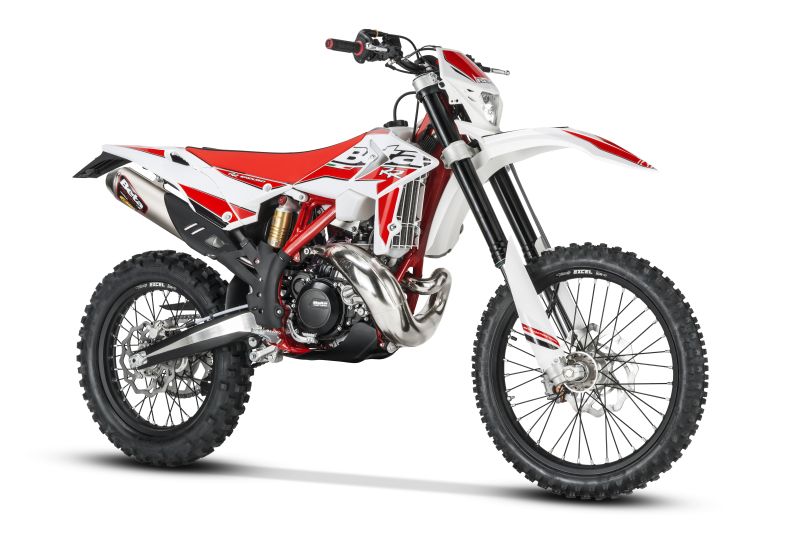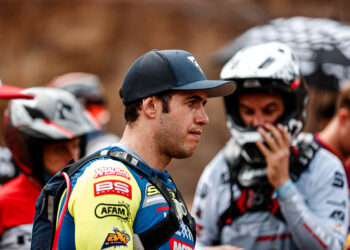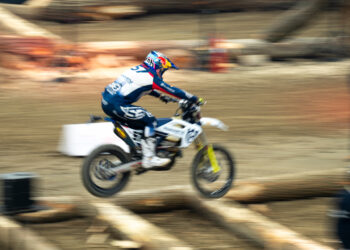The new Enduro RR my 2018 is coming on the market with many new features.
The Tuscan manufacturer was able to transfer of much of the know-how gained from the great racing successes of the 2016 season from the competition bikes to the production models after victories in both the Riders World Championship (E3 class) and the Manufacturers World Championship (EnduroGp class). The Beta engineers at Rignano, with guidance from their top riders, Steve Holcombe and Alex Salvini, have designed a new line of motorcycles that are remarkably lighter in weight with better performance than the previous models; 4.7 kg lighter for the 2-stroke versions and a whopping 5.3 kg shaved off the 4-stroke bikes.
But this drop in weight is not the only feature worthy of note. The engines, running gear and suspension are products of a significant technical evolution which has further enhanced the strengths of this new generation of RR models giving them an ease of handling with a solid and immediate feeling as well as a high degree of reliability.
The design was also revised with the introduction of a new rear fender, a new color for the plastics and graphics and, on the 4-stroke versions, a muffler with a completely new profile as well as a new internal layout.
Keeping with Beta tradition, six different displacements will be available for the RR my 2018: 250 and 300 cc 2-stroke and 350, 390, 430 and 480 cc 4-stroke models, each distinguished by their own specific character. This new range will allow every rider to find just the right Beta model at the right price.
TOP FEATURES of the RR MODELS
250cc 2T: This is Beta’s little baby, perfect for those looking for a 2-stroke bike with a gentler character and with slightly lower power and torque ratings to ensure excellent handling. No doubt, this bike will be a protagonist in this season’s E2 category of the Enduro World Championship.
300cc 2T: Made for those who love big-bore 2-stroke bikes with outstanding torque at any rpm. This is the perfect bike for those who love riding with long gearing.
350cc 4T: This is the easiest handling bike in the 4-stroke model range; it favors riding at higher revs while keeping its power output very linear.
390cc 4T: This delivers the ideal mix of handling and power while making great traction its winning hand.
430cc 4T: This engine gives great performance and delivers its best results when taking advantage of its long gearing and strong torque characteristics
480cc 4T: This bike expresses itself best on wide open spaces. Its characteristics are similar to the 430cc model but with even better output and torque range, suitable to more expert riders who are physically prepared.
Engine
Compared to the 2017 model year, a great deal of development has gone into both our two and four-stroke engines which share a series of common innovations. As well as increasing performance, these new features have shaved off about 1.7 kg from both versions:
– New clutch A total overhaul has developed a more compact and lighter weight clutch that improves its scalability, precision and stability as operating temperatures change. This solution also permits the use of a much more tapered external clutch cover, making the lines even more graceful.
– Elimination of the kick-start: the incredible work put into making the electric starter more reliable has allowed the kick-start lever to be removed, significantly reducing weight. Given the engine arrangement, a kick-start can still be ordered as an option.
– New gear shifting selector system: improves the precision of the transmission eliminating any possible uncertainties when shifting gears.
– New filter box: intense testing was done on the 4-stroke engine injection mapping and on the 2-stroke engine timing advance curves to optimize output enabling the introduction of a new filter box.
Furthermore, both the 2-stroke and the 4-stroke versions have been specially engineered for their unique architectures. Specifically:
2-Stroke:
– New cylinder: improves performance in terms of torque and power output throughout the rev range while keeping the response perfectly linear.
– Rounded piston and new cylinder head profile (300cc only): together with the new cylinder, these increase engine performance and improve rolling at low rpms.
– Crankshaft: inertia values were revised to match the new features of the power unit and the coupling axis reinforced in order to increase the stiffness of the whole structure.
– New connecting rod: revised in the top end so as to strengthen this area which is highly stressed.
– New centrifuge: with an increased diameter of spheres to better adapt to the new primary drive ratio, ensuring better power delivery.
– New combustion chamber (250cc only): thanks to a slight increase in compression ratio, an upgrade in performance was possible.
4-Stroke:
– EFI with dual injectors: The introduction of dual injectors allows the application of dedicated maps for each engine displacement in order to increase engine performance (particularly in the middle and high rpm) and to increase mixture control which subsequently increases mileage.
A great deal of attention has also gone into the rest of the motorcycle including the chassis and suspension which continues to use a Sachs rear shock absorber and Sachs 48 mm diameter front fork but with a new fork sleeves. Both vaunt specific calibration settings suitable for the demands of the new frame.
Many innovations have been combined with this time-tested solution aimed at improving the aesthetic appearance as well as the dynamic performance of the motorcycle, through a weight reduction – not counting the engine – that ranges from 3 kg for the 2-stroke models up to 3.6 kg for the 4-strokes.
– New Chassis The front-end has been completely redesigned enabling an increase in the flexural and torsional rigidity characteristics compared to previous versions and with a notable reduction in weight thanks to an improved structural layout. This generates a consistent improvement in handling and riding precision.
– Slimmer filter box and rear end giving the bike a slimmer, more aggressive look.
– Lithium battery: lighter in weight, more powerful and reliable.
– Fork with a new fork sleeves: though also lighter in weight, this was developed to increase rigidity and improve sliding. These have been specifically calibrated to suit the demands of the new chassis.
– A mono-shock absorber with new settings has been adapted for the demands of the 2018 version chassis.
– New muffler (4-stroke versions only): revised external profile and internal layout to improve engine performance, especially at low rpm.
– New skid plate (2-stroke versions only): improved fastener accessibility for quicker removal.
– New muffler heat shield: protects the rider from burns on both the 2- and 4-stroke versions.
– Takasago Excel rims: with a new opaque black finish specifically designed for Beta.
– New colors and graphics.Availability starting early July 2017. Prices to follow.












